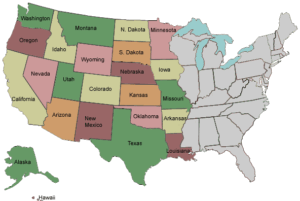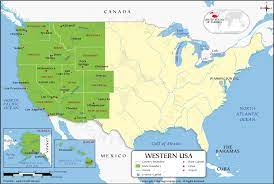Introduction to the Western US Map
The Western US map serves as a gateway to one of the most diverse and geographically significant regions in the United States. Encompassing states such as California, Oregon, Washington, Nevada, Utah, and parts of Idaho and Montana, this map highlights a rich tapestry of landscapes, cultures, and attractions that draw countless visitors each year. The area is characterized by its striking contrast between rugged mountain ranges, vast deserts, lush forests, and breathtaking coastlines.
One prominent feature appearing on a western US map is the iconic Sierra Nevada mountain range, which stretches along the eastern edge of California. This mountain system not only boasts remarkable peaks, including the famous Mount Whitney, but also houses some of the nation’s most treasured national parks, such as Yosemite and Sequoia. These parks are renowned for their dramatic scenery, towering trees, and diverse ecosystems, providing abundant opportunities for outdoor enthusiasts and nature lovers to explore and appreciate the natural world.
In addition to the mountains, the western US map reveals the impressive coastal regions along the Pacific Ocean, offering a plethora of outdoor activities and breathtaking vistas. From the sandy beaches of Southern California to the rugged cliffs of the Oregon coastline, the area is home to unique marine environments and picturesque seaside towns. Furthermore, the Great Basin in Nevada and the deserts of Utah showcase an arid beauty, with striking rock formations and a range of flora and fauna adapted to these harsh conditions.
The geographical diversity represented on the western US map underscores the unique cultural and historical significance of the region. The interplay of natural features and human settlements creates a dynamic landscape that continues to attract those seeking both adventure and solace in nature. Understanding this map’s features is crucial as we delve deeper into the specific attractions and geographical wonders that define the western United States.
Key Attractions and Landmarks on the Western US Map
The western United States is home to a diverse array of attractions and landmarks that draw millions of visitors each year. Each state showcases unique features that are often highlighted on the western US map, offering breathtaking natural landscapes and historic sites. One of the most iconic landmarks is the Grand Canyon in Arizona. This expansive gorge, carved by the Colorado River, reaches depths of over a mile and displays a variety of geological formations that narrate the Earth’s history over millions of years. Visitors can engage in activities such as hiking, river rafting, and enjoying the panoramic views from various overlooks.
Moving to California, the Golden Gate Bridge stands as a symbol of engineering prowess and scenic beauty. Spanning approximately 1.7 miles across the Golden Gate Strait, this suspension bridge connects San Francisco to Marin County. It is particularly renowned for its striking orange color and Art Deco design, making it a must-see attraction on the western US map. Besides being a transportation link, it also offers picturesque views, making it a favorite spot for photographers and tourists alike.
An additional landmark worthy of mention is Yosemite National Park, located in California’s Sierra Nevada mountains. Recognized for its stunning granite cliffs, ancient giant sequoias, and diverse ecosystems, Yosemite draws nature enthusiasts, hikers, and climbers from around the globe. The park is home to notable features such as El Capitan and Half Dome, which provide exceptional opportunities for outdoor adventures and photography.
Each of these attractions exemplifies the rich tapestry of resources available within the western US region. From natural wonders to architectural feats, exploring the western US map reveals insights into the environmental and cultural significance of these landmarks, inspiring further exploration and appreciation of this vibrant area.

Travel Tips for Exploring the Western US
When planning a journey through the vast and diverse landscapes of the Western US, it’s essential to consider various travel tips that will enhance your experience. A well-researched itinerary that aligns with the geographic features on a western US map can significantly improve your travel experience. Timing your visit is crucial; spring and fall are ideal seasons, as summer can be exceedingly hot in certain regions, while winter may bring snow that could impede travel in the mountainous areas.
Road trips remain one of the best ways to truly appreciate the beauty of the Western US, allowing travelers to explore iconic routes such as the Pacific Coast Highway and Route 66. To make the most of your journey, consider creating a flexible travel itinerary that includes major attractions such as national parks, vibrant cities, and breathtaking natural wonders. Be mindful of distances on the western US map, as many attractions can be hours apart. Planning to stay in various locations will give you the chance to fully engage with the area’s unique culture and environment.
Preparation is key, especially for outdoor adventures in national parks and wilderness areas. Ensure you have the necessary gear for hiking, camping, or skiing, depending on your chosen activities. Familiarizing yourself with local customs and etiquette will enhance cultural experiences during your travels, whether it be attending local festivals or visiting historical sites.
Accommodation options range from luxurious hotels in urban areas to campgrounds in remote landscapes, providing choices for every budget. Additionally, don’t miss the opportunity to indulge in local cuisines, which vary significantly between regions. From fresh seafood along the coasts to hearty mountain fare, the culinary experiences are as rich and varied as the region itself. Engaging with the local culture will make your trip memorable as you traverse the iconic locales depicted on your western US map.
Conclusion and Future Exploration of the Western US Map
As we reflect on the remarkable features of the Western US map, it becomes evident that this vibrant region offers an array of attractions that cater to diverse interests. From the majestic peaks of the Rocky Mountains to the serene shores of the Pacific Ocean, each location in the western United States showcases unique landscapes and thriving ecosystems. National parks like Yellowstone and Yosemite provide natural wonders that invite outdoor enthusiasts for hiking, photography, and wildlife viewing. Meanwhile, urban centers such as San Francisco and Seattle feature rich cultural scenes and histories that draw visitors year-round.
The Western US map also highlights the diversity of communities and traditions that exist within the region. Whether through Native American heritage, Spanish colonial architecture, or the influence of recent immigrants, these cultural narratives enrich the tapestry of the West and foster a deeper understanding of the American experience. Traveling through these areas provides not only scenic beauty but also meaningful insights into how geography can shape culture and community.
As we conclude our exploration, we encourage readers to look beyond the folds of the western US map and uncover the adventures that await. Each road taken leads to new discoveries, whether it’s a hidden gem of a town, a breathtaking viewpoint, or a cultural festival. Engage with the landscapes, meet the locals, and immerse yourself in the stories that this region has to share. We invite you to share your personal experiences or questions about your journeys across the western United States. Engaging with fellow travelers can enhance our understanding and appreciation for a region that continues to inspire awe and adventure.
